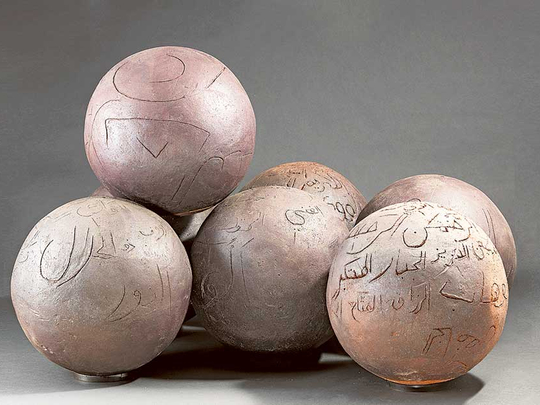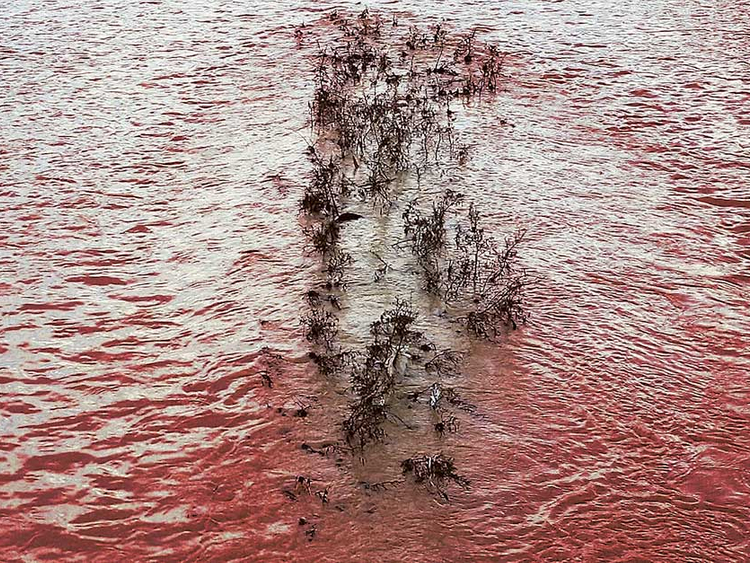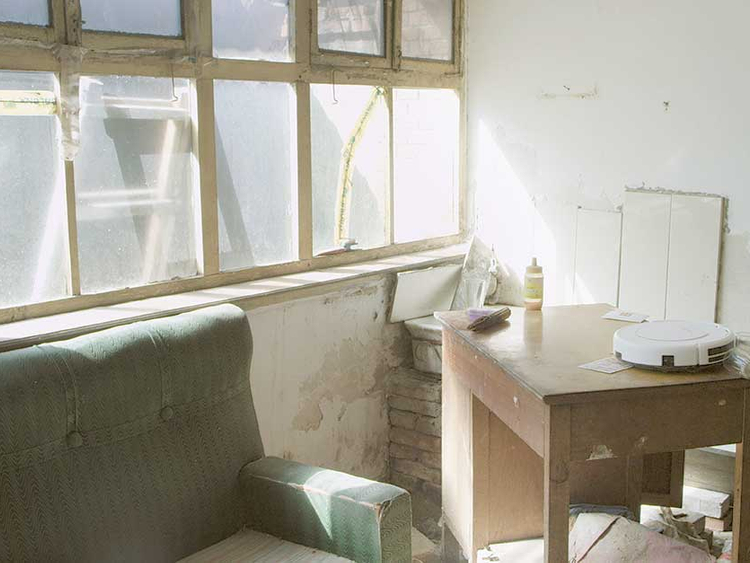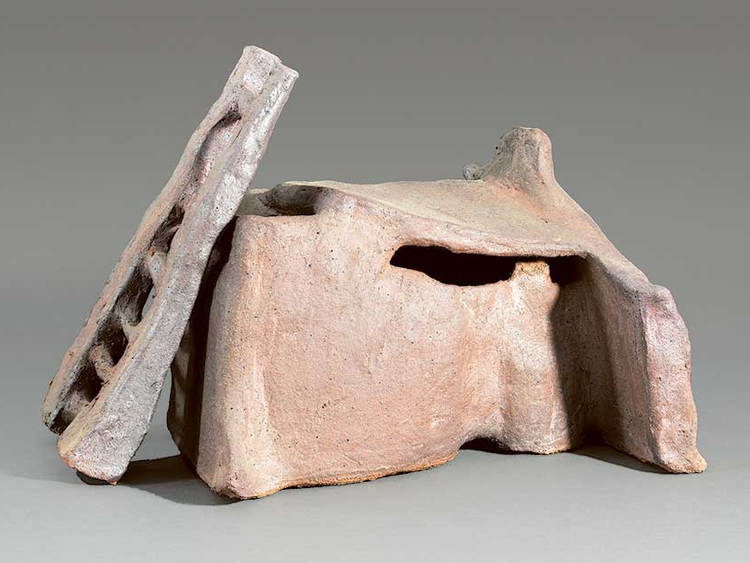
Building on the history of cultural collaboration and exchange has been the core mission of Sharjah Art Foundation (SAF) since launching the first Sharjah Biennial in 1993. This year too, the Foundation, as a run-up to the next Biennale opening in March 2017, has been organising major retrospectives and key historic shows that span a wide time frame and spectrum of Arab and global art practice.
The two shows that recently concluded at the SAF Art Spaces were a solo exhibition featuring new works by Lebanese Simone Fattal — who lives and works in Paris — curated by Sharjah Art Foundation Director Hoor Al Qasimi, and “The Time is Out of Joint” curated by Tarek Abou El Fetouh and commissioned by Asian Culture Complex — Asian Arts Theatre and SAF.
The solo exhibition titled “Simone Fattal” included sculptures, simple non-figurative ceramic forms and works based in textual compositions, collage as well as paintings.
Fattal’s work traverses the worlds of visual art and literature. She began her career as a painter in 1969, when she returned to Beirut after completing her studies in France.
In this show, Fattal’s paintings pursued variations of colour and the passage of time. The earlier paintings explore Beirut’s Mount Sannine, depicting the white and pink tonalities during and after sunset. These works provide early glimpse of her mastery of the medium. Even as the viewer takes in the work, it looms larger in spite of the minimalism of the expressive content.
The other series of paintings created almost 35 years later capture the mutable blacks and whites of the mountain and the night sky.
Fattal’s exploration of artistic medium and source material are paralleled in her equally expansive preoccupations with war, its socio-political contexts, time and ancient history.
The exhibition also presented a selection of Fattal’s works that incorporate texts from varied sources, including the works of Sufi writers, writings from the Quran and the Hadith and ancient epics, from which she often draws the mythic figures referenced in her work.
In 1980, she moved to California and founded the Post-Apollo Press, a publishing house dedicated to innovative, experimental literary work. She returned to visual art in 1989, taking up the medium of ceramics sculpture. During this period, she worked at the prestigious workshop of Hans Spinner in Grasse, France.
The artist’s two “Warrior” sculptures — Zhat El Himma and Abdel Wahab (2006) are based on two mythic heroes of the Sira, from an epic of the same name, unknown even in the Arab World.
These large standing figures are representative of those who must continually endure war and struggle and are also indicative of the artist’s larger preoccupation with the socio-political conditions in the Middle East, particularly during times the artist refers to as “fundamental upheavals”.
It is especially in these moments that Fattal finds the need to preserve and shed light on the ancient past.
The visceral qualities of clay — its seemingly primordial fragility, malleability and strength — provide the artist a medium through which she can trace the past into the present. She is able to transcend natural material and fashion a metallic sheen and strength in the objects. She situates herself along a continuum of linked images, histories and consequences that she feels to be present in her psyche, and by extension in her work.
Fattal’s other recent exhibitions include “CERAMIX, art and ceramics from Rodin to Schütte”, Cité de la céramique, Sèvres and La Maison Rouge, Paris (2015-2016); “Nel Mezzo del Mezzo”, Museo d’arte contemporanea della Sicilia, Palermo (2015); “Take Me (I’m Yours)”, Monnaie de Paris (2015), and “Here and Elsewhere”, New Museum, New York City (2014).
Her works can also be found in numerous collections, including the Sharjah Art Foundation Collection.
The theme of “The Time is Out of Joint” was inspired by Andalusian philosopher Ibn Arabi’s concept of time as a fluid place and place as a frozen time.
The project challenged the constraints of time and place by suggesting leaps across temporal and geographic boundaries, deliberately confusing times, places, cities and artistic events that took place in the past or will take place in the future.
Tarek Abou El Fetouh, an independent curator and architect who lives and works in Brussels, says, “The project challenged the constraints of conditions and locations, and moves past and future art events across times and cities.”
The show did not “seek to redraw a historical map. Rather, it presented a body of contemporary artworks and writings against the three crucial events ... intervening in layers of time and place that is at once conductive and disruptive. The project rethought artists’ gestures in a time of rupture, investigating collective challenges to authoritarian structure and gazing beyond the limits of borders.”
An extensive programme of events was part of the project, including a series of performances, film screenings, artist talks, presentations and discussions.
The project invited the audience to engage with different platforms — an exhibition; a reading room with a discursive programme, and a conference.
“The Time is Out of Joint” reenacted two pivotal exhibitions that took place during key transitional moments in history — the First Arab Arts Biennale in Baghdad (1974) and the “China/Avant-Garde” exhibition in Beijing (1989) — and pre-enacted a future event — the “Equator Conference 2022” in Yogyakarta (2022).
The Baghdad Biennale, as we know, was a result of the short-lived revival of Arab nationalism in the 1970s. Designed to travel from one Arab capital to another, the second and final edition of the biennale was held in Rabat in 1976. Shortly thereafter, the Arab nationalist concept itself collapsed altogether, along with the biennale project.
“China/Avant-Garde” took place at Beijing’s National Art Gallery a few months before the events in Tiananmen Square and the same year that the Berlin Wall fell. The exhibition was shut down by the authorities hours after its opening in response several provocative performance works; it reopened for three more days before being forcibly shut down due to an anonymous threatening letter.
“The Time is Out of Joint” featured video works, installations and photography by Zeinab Al Hashemi, Basma Alsharif, Hicham Benohoud, Ali Cherri, Venzha Christ, Cao Fei, Ho Tzu-Nyen, Meiro Koizumi, Maha Maamoun, Basim Magdy, Radouan Mriziga, Khalil Rabah, Kyohei Sakaguchi, Tita Salina, Wael Shawky, Konrad Smoleński, Song Ta, Jalal Toufic, Mark Teh, Aleksandra Waliszewska and Raed Yassin.
The exhibition also included four new commissions by the artists Venzha Christ, Maha Maamoun, Kyohei Sakaguchi and Raed Yassin.
A two-volume publication co-edited by Ala Younis was developed as part of project. The first volume of “The Time is Out of Joint” features new text and images, while the second reproduces archival material and/or reflections on such material.
Another essential component of the project, The Time is Out of Joint Reading Room, presented a platform for books that expanded on the themes in the exhibition. The reading room was conceptualised by Marwa Arsanios and Samer Frangie.
N.P. Krishna Kumar is a freelance writer based in Dubai.













